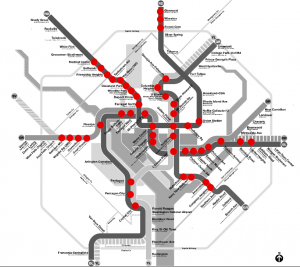New Station Mezzanine Lights Show the Way
Pilot upgrades using energy-efficient lighting at three stations have been a success, so Metro is planning to ramp up the effort to 41 more stations by 2015.
Metro recently completed retrofitting the mezzanine-level lights at Judiciary Square, Gallery Place, Bethesda, Smithsonian and Metro Center. Through careful fixture selection, the new fixtures provide a higher quality of light with an improved Color Rendering Index (CRI) thereby improving both lighting levels and overall visibility. Significantly, the new lighting design offers better light levels without compromising the integrity of the original lighting design and station aesthetic. The retrofits also provide significant lifecycle cost savings for Metro through reduced energy consumption and maintenance requirements.
Following these successes, Metro General Manager/CEO Richard Sarles today that it plans to upgrade mezzanine lighting at the 41 remaining underground Metrorail stations by 2015. In addition to the five already completed stations, one station, L’Enfant Plaza is currently under construction.
The mezzanine lighting program builds on previous successful lighting upgrade projects including Light Emitting Diode (LED) retrofits at platform edges and twist-in LED upgrades to 33 stations access corridors and fare areas during which over 2,180 were replaced and recycled throughout the system. Metro is committed to continually improving the customer experience and lighting efficiency upgrades will continue to be rolled out as part of this process.
The lighting improvements are the result of an effective partnership between Metro, the Accessibility Advisory Committee (AAC), and other community stakeholders, including the National Capital Citizens with Low Vision. The year-long efforts of this partnership highlighted specific lighting needs in stations and developed recommendations for improvements, many of which have been implemented.
Where will the new lights be installed? The rail map below shows underground stations that have been completed or are slated for upgrades:

The underground stations marked in red are slated for, or have recently been fitted with mezzanine lighting upgrades.
Have you seen the new lights? What do you think? Please let us know in the comments section below.



Anyone calculating the energy savings and putting a dollar value to it?
also, that’s good news….
I’ve been at L’Enfant where they just put these in the mezzanines, and it is a huge – and very welcome – improvement! It makes the area feel so much safer, as compared to the dark and mostly broken ‘can’ lights that were there before. I really cannot wait for these improvements to be completed at other stations I pass through.
BTW – does anyone know what is going on at Smithsonian? They have the ‘blue walls’ along each side of the platform but I cannot figure out what is going on….
This is amazing!!!! Great job WMATA, keep doing more stuff like this
About time. Having used New York’s subway, as well as London, Paris, San Francisco and Madrid’s, Washington D.C. system is the darkest and the dingiest. Brighter lighting is safer and actually shows off how clean it is too!
What would be great is if the smart looking signage at Gallery Place is replicated throughout the system. Don’t need to “test it” or study it, or pass a resolution to empower a committee to recommend a consultant to prepare a report on the best process to put new signage in the system. JUST DO IT.
@DG that new signage, which I assume you’re referring to the way finding signage that is white/black/gray, is rolling out throughout the system as part of the update for the Silver Line.
Or you could just clean off the lights that already exist and replace the bulbs along with some powerwashing of the concrete vaults…might do the trick and keep it uniform. The Metro isn’t even that dark.
We are tracking the energy and associated dollar savings that the upgrades are producing. @jnb
would be nice to hear any plans for out door Mezzanine lighting to make it more engery friendly. Even changing the current blubs to LEDS.
Better yet more even lighting and brighter would be amazing.
I even thought about why not add one or two propane heaters for winter service that would only be on during the cold of the cold.